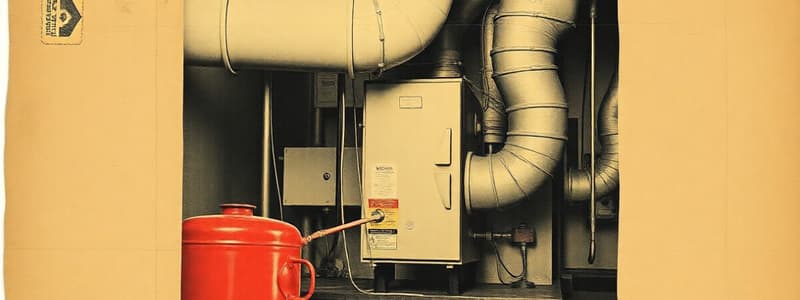Podcast
Questions and Answers
What type of venting system is used by Category 1 furnaces?
What type of venting system is used by Category 1 furnaces?
- Positive pressure venting
- Balanced pressure venting
- Direct venting
- Negative pressure venting (correct)
Which of the following is a characteristic of Category 4 furnaces?
Which of the following is a characteristic of Category 4 furnaces?
- Flue temperatures reach up to 600°F
- Require masonry chimneys
- Non-condensing type
- Use PVC for venting (correct)
What is the primary disadvantage of Category 2 furnaces in residential settings?
What is the primary disadvantage of Category 2 furnaces in residential settings?
- Easier to install
- Higher installation costs (correct)
- Require less maintenance
- Produce less heat
Which of the following factors has the least influence on venting performance?
Which of the following factors has the least influence on venting performance?
What flue gas temperature can Category 1 furnaces reach?
What flue gas temperature can Category 1 furnaces reach?
What is the recommended minimum height for ventilation extensions above the roof?
What is the recommended minimum height for ventilation extensions above the roof?
Which chimney type is typically associated with masonry construction?
Which chimney type is typically associated with masonry construction?
What primarily differentiates Class B chimneys from Class A?
What primarily differentiates Class B chimneys from Class A?
Flashcards
Category 1 Furnace
Category 1 Furnace
Older, non-condensing furnace with negative pressure venting. Flue temperatures can reach 140°F or higher due to inefficient combustion.
Category 2 Furnace
Category 2 Furnace
Condensing furnace with negative pressure venting. Requires special venting materials (often stainless steel) and is less common in residential settings.
Category 3 Furnace
Category 3 Furnace
Non-condensing furnace with positive pressure venting. Requires special venting materials and limited residential use due to high installation costs.
Category 4 Furnace
Category 4 Furnace
Signup and view all the flashcards
Backdraft
Backdraft
Signup and view all the flashcards
Minimum Chimney Height
Minimum Chimney Height
Signup and view all the flashcards
Class A Chimney
Class A Chimney
Signup and view all the flashcards
Metal Flex Liner in Class A Chimneys
Metal Flex Liner in Class A Chimneys
Signup and view all the flashcards
Study Notes
Furnace Venting Categories
- Category 1 furnaces use negative pressure venting for non-condensing models.
- Flue temperatures can reach 140°F or higher, with minimal condensation in the flue pipe.
- These are often older, standing pilot models, vented by natural convection.
- Category 2 furnaces also employ negative pressure venting, but are condensing furnaces.
- Special venting materials (often stainless steel) are required due to condensation.
- Residential applications are limited due to higher installation costs; more common in industrial and commercial settings.
- Category 3 furnaces utilize positive pressure venting for non-condensing models.
- These also require special venting materials (often stainless steel).
- Residential use is limited by high installation costs and limited applications.
- Category 4 furnaces employ positive pressure venting for condensing models.
- Flue temperatures stay below 140°F, with flue gas condensing and draining as liquid.
- These are high-efficiency furnaces with secondary heat exchangers, and can use PVC venting.
Factors Influencing Venting Systems
- Furnace capacity must match the building's heating load.
- The building's heat load dictates the amount of heat needed for comfort.
- Flue pipe material and construction impact performance.
- Shorter flue pipes minimize heat loss.
- Gas flow rate affects combustion air intake and flue gas exhaust.
- Each elbow or bend in the system increases flow resistance.
- Flue gas temperature affects flow; too cold slows it, too hot is inefficient.
Vent System Installations
- Vent extensions must extend at least 2 feet above the highest roof point to prevent backdraft.
- Backdraft occurs when negative pressure draws exhaust gases back indoors.
- Category 1 furnaces (lower efficiency) can produce high flue gas temperatures (up to 500-600°F).
- Chimney types include Class A (masonry), Class B (double-wall metal pipe), and PVC (for high-efficiency condensing furnaces).
- Metal flex liners in Class A chimneys require proper sizing, installation, and clearance from the chimney.
- High-efficiency furnaces use PVC venting due to lower flue gas temps (100-150°F).
- Fresh air intake is necessary for high-efficiency furnaces, often using PVC piping (sometimes in a concentric configuration).
- PVC installation requires leak-proof sealing with primer and cement, plus proper condensation drainage.
- Flue pipes should pitch ¼ inch per foot towards the furnace for proper drainage.
Vent System Components
- Draft regulators control indoor air intake and stabilize flue gas flow.
- Common types include thermostatic, electric, and barometric regulators.
- Thermostatic regulators open based on flue gas temperature.
- Electric regulators are motor-controlled, communicating with thermostats.
- Barometric regulators operate based on pressure differences.
Studying That Suits You
Use AI to generate personalized quizzes and flashcards to suit your learning preferences.
Description
Explore the four main categories of furnace venting, focusing on their specific characteristics, applications, and requirements. This quiz covers Category 1 through Category 4 furnaces, detailing aspects such as pressure type, condensation, and materials used. Perfect for anyone looking to understand HVAC systems better.




